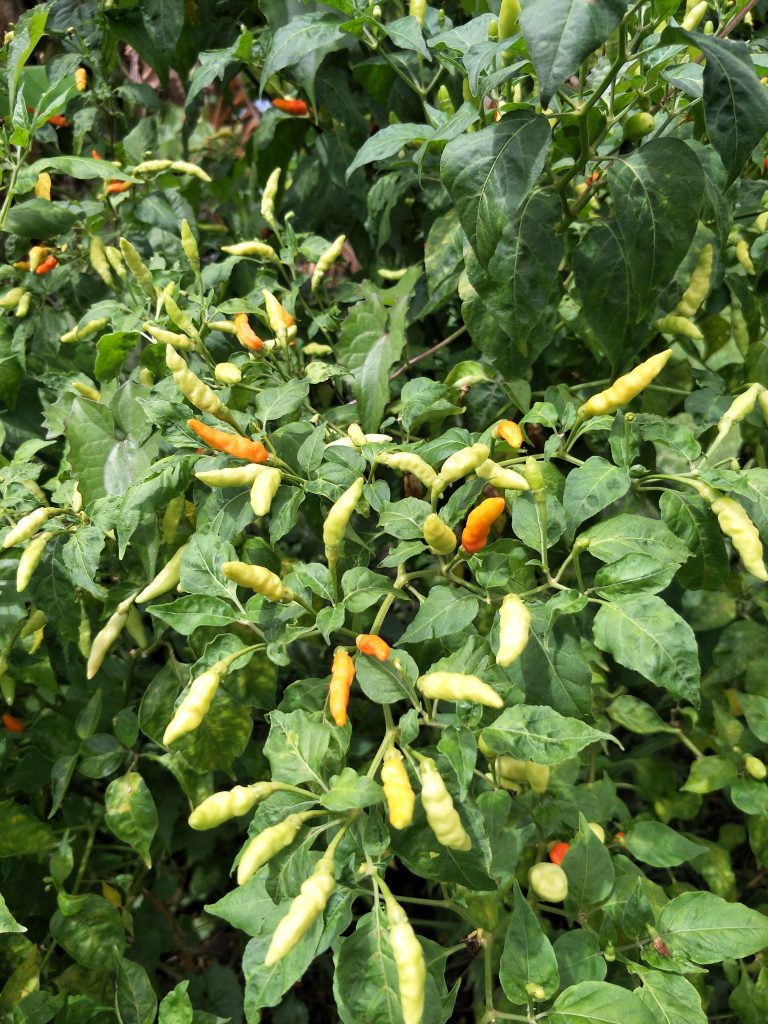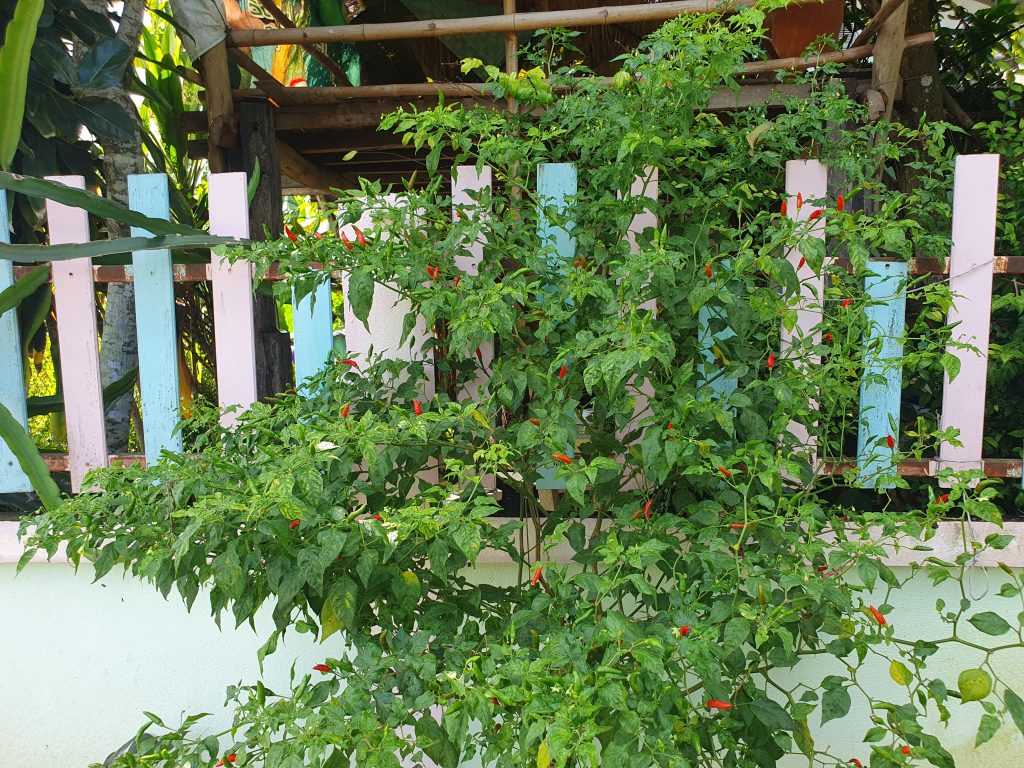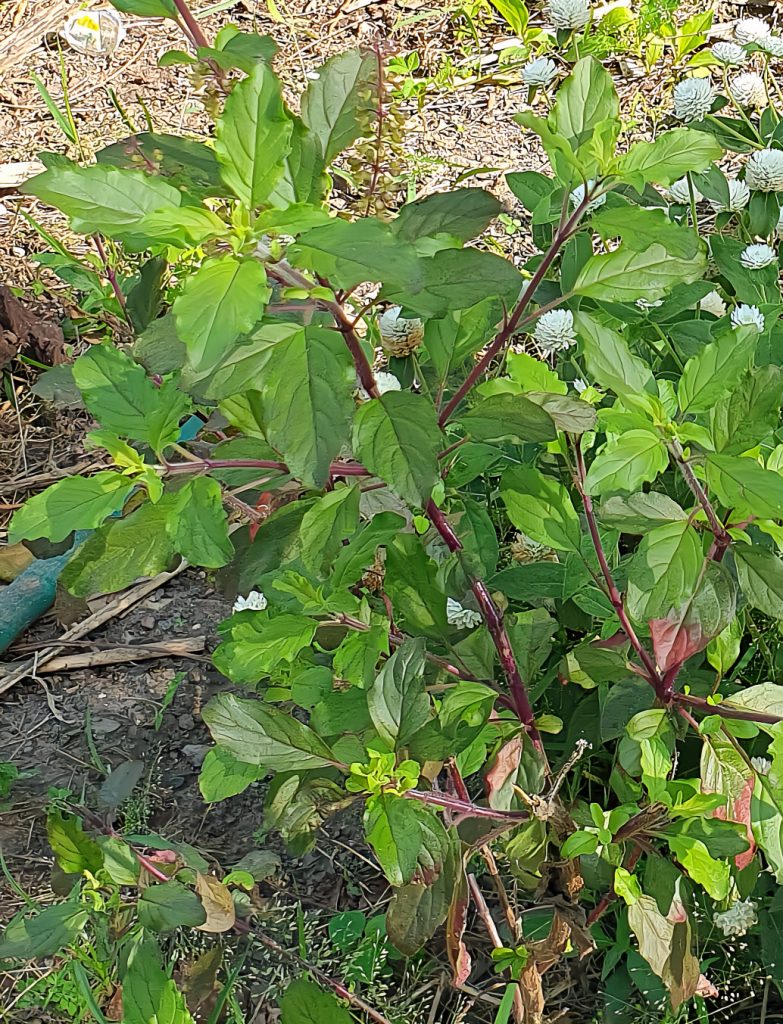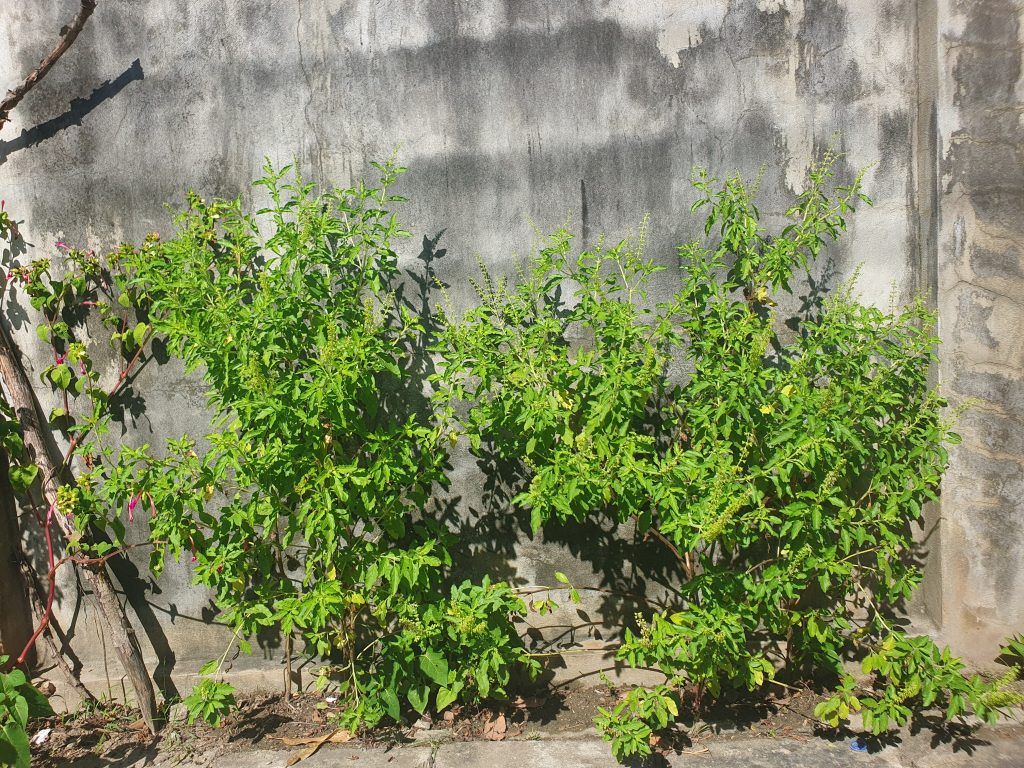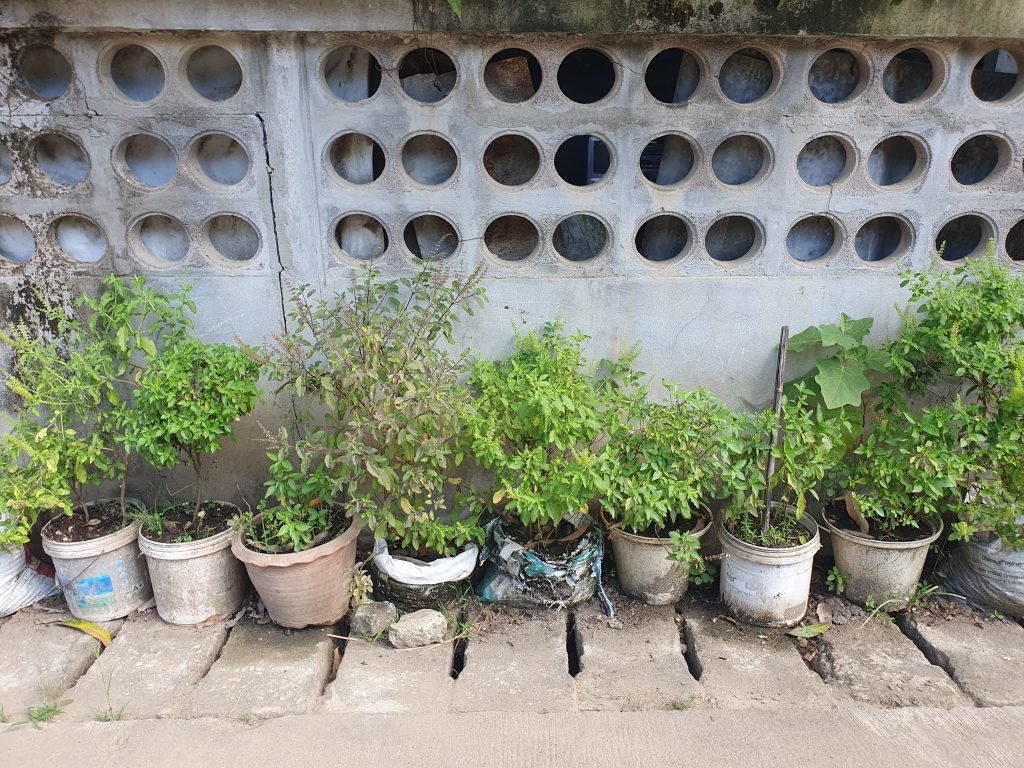Ich habe mich mal umgehört in meiner Nachbarschaft. Das Ergebnis war erstaunlich! Warum? Weil die Thailänder unter den Befragten, allesamt spezielle Pflanzen im Blick hatten. Wir, die Zugereisten, holten unsere Antworten aus der bewussten Beobachtung heraus und lagen damit ziemlich weit vorne.
Das ist aber nicht weiter ungewöhnlich, denn in der eigenen Umgebung werden viele Dinge mit der Zeit so normal und selbstverständlich, dass sie kaum noch bewusst wahrgenommen werden. (Info an mich: mein Umfeld häufiger Mal mit anderen Augen, aus anderen Perspektiven, mit einem speziellen Themen-Fokus wahrnehmen!). Wenn du magst, berichte doch mal, wie das mit den „Five“ bei dir, in Südthailand, Kalifornien, Holland, Neuseeland, England, Italien, Deutschland oder sonst wo auf der Welt in den Gärten aussieht! (Am besten befragst du dafür Zugereiste! 😉 )
Doch jetzt weiter zu den fünf Pflanzen, die nahezu jeder Thai in seinem Garten hat. Im Norden Thailands wohlbemerkt! Kann gut sein, dass es weiter südlich anders aussieht. Ach ja, und meine Ergebnisse basieren natürlich auf repräsentativen „Umfragen“, „objektiven“ Beobachtungen und kommen daher meiner gefühlten Realität verdammt nahe. Schluss mit dem Geschwafel, hier ist das Endergebnis für euch!

I did a little survey in my neighborhood and the results were surprising! Why? Because the Thais among those surveyed all had their eyes on specific plants. We, the newcomers, gathered our answers from conscious observation and were surprisingly ahead. However, this isn’t unusual, as many things in our surroundings become so normal and taken for granted that they are hardly consciously noticed. (Note to myself: observe my surroundings more frequently with different eyes, from different perspectives or with a specific thematic focus!) Feel free to report the „five“ in your area, from the gardens in South Thailand, California, Holland, New Zealand, England, Italy, Germany or anywhere else in the world! (best to ask foreigners! 😉)
But now, let’s get back to the five plants that almost all Thais have in their gardens. In Northern Thailand, mind you! It might look different further south. My results based on “representative” surveys, “objective” observations and come pretty close to my felt reality. Enough chit-chat, here’s the final result for you!

Melanolepis multiglandulosa, Pak chai ya, ผักไชยา
Da kannst du noch so lange googeln oder deine KI ausquetschen, da wird nicht viel kommen. Keine Rezepte und auch kein englischer oder deutscher Name.
Diese Pflanze ist unverwüstlich und allgegenwärtig in Thailand. Namensidee, Überallus spinacii. Nein, so ein richtig feines Spinataroma hat sie nicht. Dennoch wird sie gern als Gemüsebeigabe im Wok zubereitet, weil sie ja nun mal da ist. Außerdem liefert sie eine gehörige Portion Pflanzenproteine und gesunde sekundäre Pflanzenstoffe. Sie enthält allerdings auch Cyanide (Blausäureverbindungen), weshalb sie nur gegart verzehrt werden soll, halt ähnlich wie unsere Bohnen. Wenn du hier lebst, schau dich mal um, sie ist wirklich überall. Selbst wir haben so eine Pflanze im Garten, frag mich nicht woher und warum. Wenn du sie irgendwann entnervt abschneidest, weil sie immer höher wächst, dann sieht sie nach einem Monat wieder so aus, als wäre nix gewesen. Nur der Stamm wird unten dicker und dicker.

Melanolepis multiglandulosa, Pak chai ya, ผักไชยา
You can google as long as you want or squeeze your AI, not much will show up. No recipes and no English or German names. This plant is indestructible and you see it here everywhere. Name idea, omnipresentus spinacii. No, it doesn’t have a really fine spinach aroma. Nevertheless, it is gladly prepared as a vegetable addition in the wok because it’s there. It also provides a considerable amount of proteins and healthy secondary plant substances. However, it does contain cyanide (cyanide compounds) as well, so it should only be consumed cooked, similar to our beans. If you live here, take a look around, it’s everywhere! Even we have such a plant in the garden, don’t ask me where it comes from. If you eventually cut it off in frustration because it keeps growing to high, it will look like before in just one month. Only the stem gets thicker at the bottom.
Chili, พริก
Kaum ein Gericht findet in Thailand ohne Chili Beachtung. Getrocknet, gebraten, geflockt, als Pulver oder frisch rein geschnippelt in Essig und Fischsauce, Chili ist immer auf dem Tisch! Chilisträucher blühen unermüdlich, haben immer Saison und sind recht anspruchslos. Mehr als beruhigend also, ein bis vier Chili-Pflänzchen in der Nähe zu wissen.
Die bekanntesten Thai Chilisorten sind die kleinen Prik Kee Noo (พริกขี้หนู) und die etwas größeren und milderen Prik Chi Fa ( Capsicum annum / พริกชี้ฟ้า).
Mehr gibt es zu diesem wundervollen Gewächs nicht zu sagen. Wenn du die Schärfe nicht verträgst, trainiere ein wenig oder lerne die Worte „prik sun met“ (null Chili). Weil: „nicht so scharf, mai ped, not spicy“ beim Empfänger selten so ankommt, wie du es ausgesendet hast.
Chili, พริก
Hardly any dish in Thailand goes without paying attention to chili. Dried, fried, flaked, as powder, or freshly chopped in vinegar and fish sauce, chili is always on the table! Chili plants bloom tirelessly, always in season, and are quite undemanding. So, it’s reassuring to have one to four chili plants nearby.
The most well-known Thai chili varieties are the small Prik Kee Noo (พริกขี้หนู) and the slightly larger and milder Prik Chi Fa (Capsicum annum / พริกชี้ฟ้า).
There’s not much else to say about this wonderful plant. If you can’t handle the heat, train a bit or learn the words “prik sun met” (zero Chili). Because “mai ped or not spicy” rarely lands with the recipient as you intended.
Kaprao, ใบกะเพรา
Ocimum tenuiflorum, Holy Basil, indisches Basilikum, Tulsi, ein tolles aromatisches Kraut! Der Geschmack ist frisch, würzig, herb und leicht scharf. Es wächst wie „Unkraut“ und findet Platz in der kleinsten Ecke. So sind immer ein paar Blättchen zur Hand, um einen gesunden Tee oder das beliebte Pad Kaprao, ผัดกะเพรา, zuzubereiten. Ein Tulsi Tee wird häufig in der ayurvedischen Medizin verwendet. Unzählige gesundheitliche Vorteile werden ihm nachgesagt, unter anderem gilt er als Blutdruck- und Blutzucker-Senker. Das Gericht Pad Kaprao bekommst du fast überall, wo du einen Wok in der Küche sehen kannst. Das Aroma der im besten Fall schön knusprig gebratenen Blätter kommt mit einem Mix aus Chili und gehacktem Schweine-, Hühner- oder Entenfleisch wunderbar zur Geltung. Ich mag es gern mit einem gebackenen Ei (sai kai dao) auf dem Reis.
Kaprao, ใบกะเพรา
Ocimum tenuiflorum, Holy Basil, Indian Basil, Tulsi, a fantastic aromatic herb! The taste is fresh, spicy, herbal and slightly hot. It grows like “weeds” and finds a place in the smallest corner. So, there are always a few leaves on hand to make a healthy tea or the popular Pad Kaprao, ผัดกะเพรา. Tulsi tea is often used in Ayurvedic medicine, with numerous health benefits attributed to it, including lowering the blood sugar and blood pressure. The dish Pad Kaprao can be found almost everywhere you can see a wok in the kitchen. The aroma of the crisply fried leaves, ideally, comes to life with a mix of chili and chopped pork, chicken, or duck meat. I like it with a fried egg (sai kai dao) on top of the rice.
Papaya, Malagoo, มะละกอ
Die vielen schwarzen Samenkügelchen im leuchtend orangenen Fruchtfleisch sehen aus wie Riesenkaviar. Beim Saubermachen springen sie gern durch die Gegend. Weshalb man sich gar nicht dagegen wehren kann, dass sich im Umfeld unerwartet mal ein Papaya Bäumchen gen Himmel streckt. Die unreifen Früchte sind für den beliebten Som Tam (Papaya-Salat) unverzichtbar. Zum Nachtisch serviert man die reifen, saftigen Fruchtstücke. Die Verwendung von Samen und Blätter hat sich hier noch nicht etabliert. Schade eigentlich, weil der gesundheitliche Nutzen recht groß sein soll und im Westen zum Teil ganz schön viel für die getrockneten Pflanzenteile gezahlt wird. Die Kerne kannst du roh mitessen (Enzyme, Ballaststoffe, pfeffriger Geschmack) oder du trocknest sie. Sie lassen sich dann mörsern oder in einer Pfeffermühle mahlen. Als Bestandteil einer Trockenmarinade, ein prima Zartmacher von rotem Fleisch. Die getrockneten Blätter werden als Tee gehandelt, der in der Kräuterheilkunde aufgrund seiner Pepsine für eine Reihe von internistischen Problemen empfohlen wird.
Papaya, Malagoo, มะละกอ
The many black seeds in the brightly orange flesh look like giant caviar. When cleaning, they like to jump around, making it inevitable for a papaya tree to unexpectedly stretch towards the sky in the vicinity. Raw fruits are indispensable for the popular Som Tam (Papaya Salad). For dessert, serve the ripe, juicy fruit pieces. The use of seeds and leaves hasn’t quite established itself here yet, which is a shame because their health benefits are said to be significant. In the West, high prices are paid for the dried plant parts. You can eat the seeds raw with the fruit (enzymes, fibers, peppery taste) or dry them. You can mortar or grind them in a pepper mill. Mix it in a marinade you prepare for your meat, it´s a perfect tenderizer for grilled meat. The dried leaves are traded as tea, recommended in herbal medicine for a range of internal problems due to its pepsins.
Bananen, กล้วย
Ja, was soll man dazu sagen, mindestens ein Bananenbaum lässt sich immer irgendwo einpflanzen. Mit etwas Glück gibt es sogar reichliche Ernte. Bis zu zwanzig Sorten kennt man in Thailand, eine aromatischer als die andere. Mit diesem Energieriegel bist du immer save. Die Thais lieben sie auch getrocknet, als Bananenchips, als gegrillte Knabberei oder als Füllung für allerlei Süßkrams. Es gibt hier sogar hin und wieder noch die Ur-Banane (Kluai Namwa, กล้วยน้ำว้า)! Die sind recht kurz, dick, aromatisch und sie hat tatsächlich noch richtig dicke Samenkerne! Verrückt, oder?
Dennoch Bananen, man hat sie hier entweder grad nicht oder grad zu viele. Grad nicht, dann geh zum Nachbarn. Zu viele? Dann mach so ein Bananenbrotkuchending daraus oder friere sie stückweise ein. Dann schmeiß sie tiefgefroren nach Bedarf in den Mixer für deinen nächsten Smoothie.
Bananas, กล้วย
Yes, bananas, what can one say, at least one banana tree can always be planted somewhere. With a bit of luck, there might even be a bountiful harvest. Up to twenty varieties are known in Thailand, each more aromatic than the other. With this energy bar, you are always safe. Thais love them as well dried as banana chips, as grilled snacks, or as a filling for all sorts of sweets. There is even the original banana (Kluai Namwa, กล้วยน้ำว้า) here to get! They are quite short, thick, aromatic, and indeed, it is the original banana! It has thick seeds! Crazy, right? Nevertheless, bananas, you either don’t have them or you have too many. If no bananas, go to the neighbor. Too many bananas? Then turn them into a banana-bread-cake-thing or freeze them in pieces. As needed throw them frozen into the blender for your next smoothie.
Mit diesen fünf Pflanzen ist man versorgungstechnisch schon mal verdammt gut aufgestellt. Kein Wunder, Thailand ist ja praktisch ein großes tropisches Gewächshaus und wir dankbar und staunend mitten drin!
P.S.: In den nächsten Tagen muss ich noch mindestens zwei Pflanzen nachliefern! Fünf haben leider nicht ganz ausgereicht. Aroma und Schönheit, das werfe ich dazu schon einmal als Vorgeschmack in die geschätzte Runde. Bis dann!
With these five plants you are already in a pretty good position in terms of supply. Actually, living in Thailand is like living in a big tropical greenhouse. How blessed to be here in the middle of this botanical paradise!
P.S.: I have to deliver at least two more plants in the next few days! Unfortunately, five were not enough. As a little foretaste, it´ll be about aroma and beauty! See you!



